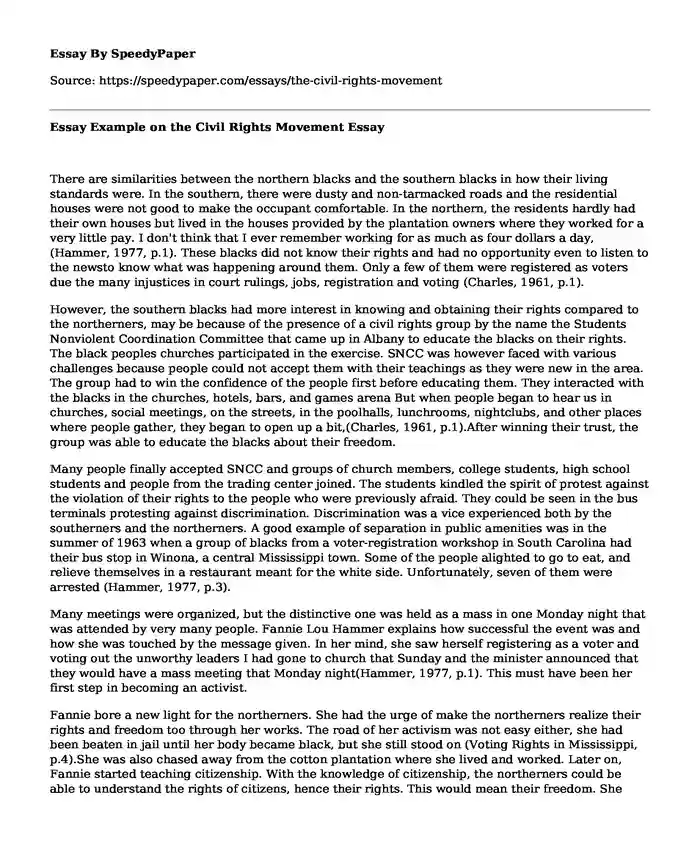
| Type of paper: | Essay |
| Categories: | History Discrimination United States Civil rights |
| Pages: | 3 |
| Wordcount: | 703 words |
There are similarities between the northern blacks and the southern blacks in how their living standards were. In the southern, there were dusty and non-tarmacked roads and the residential houses were not good to make the occupant comfortable. In the northern, the residents hardly had their own houses but lived in the houses provided by the plantation owners where they worked for a very little pay. I don't think that I ever remember working for as much as four dollars a day, (Hammer, 1977, p.1). These blacks did not know their rights and had no opportunity even to listen to the newsto know what was happening around them. Only a few of them were registered as voters due the many injustices in court rulings, jobs, registration and voting (Charles, 1961, p.1).
However, the southern blacks had more interest in knowing and obtaining their rights compared to the northerners, may be because of the presence of a civil rights group by the name the Students Nonviolent Coordination Committee that came up in Albany to educate the blacks on their rights. The black peoples churches participated in the exercise. SNCC was however faced with various challenges because people could not accept them with their teachings as they were new in the area. The group had to win the confidence of the people first before educating them. They interacted with the blacks in the churches, hotels, bars, and games arena But when people began to hear us in churches, social meetings, on the streets, in the poolhalls, lunchrooms, nightclubs, and other places where people gather, they began to open up a bit,(Charles, 1961, p.1).After winning their trust, the group was able to educate the blacks about their freedom.
Many people finally accepted SNCC and groups of church members, college students, high school students and people from the trading center joined. The students kindled the spirit of protest against the violation of their rights to the people who were previously afraid. They could be seen in the bus terminals protesting against discrimination. Discrimination was a vice experienced both by the southerners and the northerners. A good example of separation in public amenities was in the summer of 1963 when a group of blacks from a voter-registration workshop in South Carolina had their bus stop in Winona, a central Mississippi town. Some of the people alighted to go to eat, and relieve themselves in a restaurant meant for the white side. Unfortunately, seven of them were arrested (Hammer, 1977, p.3).
Many meetings were organized, but the distinctive one was held as a mass in one Monday night that was attended by very many people. Fannie Lou Hammer explains how successful the event was and how she was touched by the message given. In her mind, she saw herself registering as a voter and voting out the unworthy leaders I had gone to church that Sunday and the minister announced that they would have a mass meeting that Monday night(Hammer, 1977, p.1). This must have been her first step in becoming an activist.
Fannie bore a new light for the northerners. She had the urge of make the northerners realize their rights and freedom too through her works. The road of her activism was not easy either, she had been beaten in jail until her body became black, but she still stood on (Voting Rights in Mississippi, p.4).She was also chased away from the cotton plantation where she lived and worked. Later on, Fannie started teaching citizenship. With the knowledge of citizenship, the northerners could be able to understand the rights of citizens, hence their rights. This would mean their freedom. She went all over the county teaching citizenship education until she became field secretary for SNCC an organization that great impact in the southerners through public education in human rights. Fannie eventually became a leader of the Mississippi Freedom Democratic Party (Hammer, 1977, p.1). Her quest for freedom from oppression and equality in provision of public services made her go up the ladder by becoming the party leader. This created an opportunity of saving her fellow black northerners towards fulfilling her dream. She brought liberation to the northerners.
References
Charles, S. (1961). SNCC Memorandum.
Hammer, F. L. (1977). Voting Rights In Mississippi.
Cite this page
Essay Example on the Civil Rights Movement. (2019, Dec 13). Retrieved from https://speedypaper.com/essays/the-civil-rights-movement
Request Removal
If you are the original author of this essay and no longer wish to have it published on the SpeedyPaper website, please click below to request its removal:
- Grad School Application Essay, Free Example for You
- Essay Sample on Creativity and Systematic Innovation Systems in Business
- Free Essay on Amazon.com Business Combinations and Financial Results Analysis
- Police and Community Relations. Essay Example
- All's Well That Ends Well by Shakespeare on Character's Realism. Free Essay
- Free Essay on Popular Entertainment During the Roman Empire
- Color Consciousness in America: Unveiling Complexities, Media Portrayals, and Solutions - Paper Example
Popular categories




